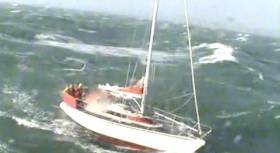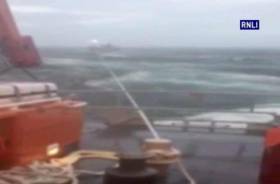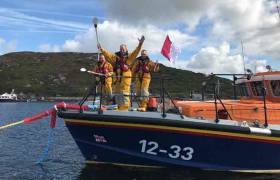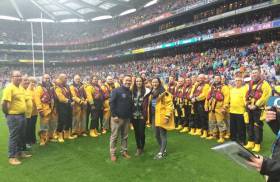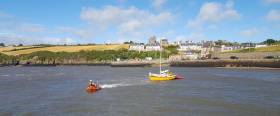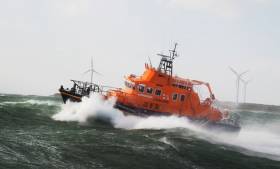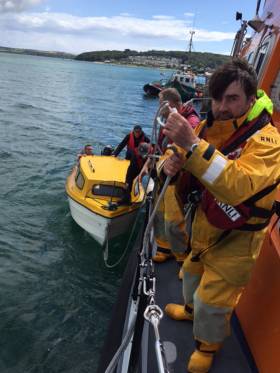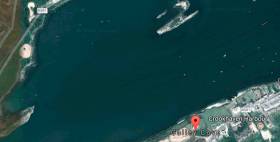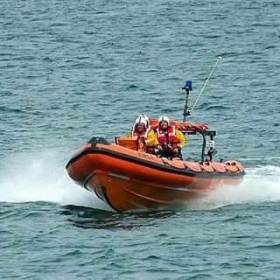Displaying items by tag: Lifeboat
Storm Ophelia VIDEO: Rosslare Harbour RNLI Rescues Three People After Yacht Mayday
Volunteer lifeboat crew with Rosslare RNLI launched this morning (Monday 16 October) during Storm Ophelia to rescue three men onboard a 10m yacht after they issued a Mayday. The crew had been trying to get to safety since the early hours and had attempted to gain entry to a few harbours but were constantly pushed back by winds and tides. Ten miles offshore from Rosslare and getting battered by the worsening weather they issued a Mayday before being rescued by the lifeboat crew.
Rosslare Harbour lifeboat, under the command of Coxswain Eamon O’Rourke launched with six volunteer crew and made the journey out to help the three men. Conditions were extremely challenging with force nine winds with a six metre sea swell. The lifeboat had to be carefully manoureved alongside the yacht by Coxswain O’Rourke to establish a tow.
The lifeboat crew made slow progress in the heavy weather but brought all three men safely ashore after 2pm at Rosslare Harbour.
Commenting on the call out, Dave Maloney, Rosslare RNLI Lifeboat Operations Manager said: ‘I am extremely proud of our crew. When the pagers went off this morning, as the storm was beginning to take hold, we had seven lifeboat crew down immediately to the station with a further six in reserve. Conditions were very unpleasant out there and we needed to get those three men to safety as quickly as possible.’
‘The crew of the yacht had been trying to come ashore since the early hours but were pushed back and ultimately unsuccessful. When the lifeboat crew reached them they were side on to the weather, taking a ferocious pounding and in danger of getting overwhelmed. I think if another hour had passed this story may not have had such a successful outcome.’
Portrush RNLI in 15 hour Call Out to Rescue Six Fishermen From 15m Boat with Engine Failure (VIDEO)
Portrush RNLI has rescued six fishermen during what was a 15 hour call out for the volunteers in rough weather conditions after the fishing boat sustained engine failure off the Donegal coast.
The lifeboat crew was requested by Belfast Coastguard to launch their all-weather lifeboat at 10.37pm last night (Sunday 1 October) and go to the assistance of a 15m fishing vessel which had suffered engine failure approximately 10 miles north of Malin Head.
The all-weather lifeboat under Coxswain Mark Mitchell and with six crew members onboard, launched and made its way to the scene in stormy conditions. The weather was overcast with showers and moderate seas as the boat launched but conditions progressed to a force 8 south westerly gale as the lifeboat approached Malin Head.
The lifeboat arrived on scene at 0.45am and the crew assessed that the six fishermen were safe and well before working with them to establish a towline.
With a tow set up, the lifeboat proceeded to take the fishing vessel into Lough Swilly. However, with deteriorating weather conditions and with both the tide and wind against them, a decision was made to tow the boat into Greencastle.
During what was a slow tow, the lifeboat was assisted by Lough Swilly RNLI’s all-weather lifeboat which launched at 8am and assisted in bringing the fishing boat into Greencastle and putting the boat on its moorings.
The Portrush lifeboat crew arrived back at their station at approximately 1.15pm today.
Speaking following the call out, Keith Gilmore, Portrush RNLI Lifeboat Operations Manager said: ‘This has been a long and challenging call out for our volunteers in what were rough weather conditions but they were delighted to have been of assistance to the six fishermen who we would like to commend for doing the right thing and raising the alarm when their boat sustained engine failure. This call out is a fine example of volunteers showing their willingness to forgo a night’s sleep and the comfort of a warm bed and some food and using their skill and experience to face challenging weather conditions to help bring others to safety.’
Clifden RNLI Hoping for Galway Double as All-Weather Lifeboat Gets Go-Ahead
Volunteer lifeboat crew at Clifden RNLI are celebrating the news that their all-weather lifeboat is to be permanently allocated at the Connemara lifeboat station following a successful trial which has seen 50 launches by the lifeboat crew and 32 people rescued or assisted. They are now hoping that their good luck rubs off on their fellow countymen this weekend and that the Galway hurlers bring home the Liam MacCarthy cup.
The RNLI and the GAA have announced a major partnership this year for the charity’s Respect the Water drowning prevention campaign aimed at sharing lifesaving advice and information through the sporting organisation’s clubs. In celebrating their good news, lifeboat crew from Clifden RNLI proudly flew the Galway colours in support of the county’s hurlers who are due to play Waterford in the All Ireland final.
The volunteer lifeboat crew first took ownership of an all-weather lifeboat in August 2014 when the Pride and Spirit was officially put on service and became a declared search and rescue asset for a trial period. The lifeboat operated alongside the two inshore lifeboats at the station. The decision followed an in-depth review of lifeboat cover in the area.
John Brittain, Clifden RNLI Lifeboat Operations Manager confirmed that the station had received word from the RNLI Trustees that the trial had been a success and the lifeboat will be made permanent.
‘The all-weather lifeboat has enabled us to provide lifesaving cover in all weathers up to 100 miles off the Connemara coast and it has complemented our inshore lifeboat service. During the trial period the all-weather lifeboat has enabled us to assist in and complete medical evacuations from the island of Inishbofin and Inishturk as well as providing assistance to a variety of boats and people in distress.
‘I would like to commend the dedication of our volunteer crew members here in Clifden who have devoted their time to ensure the period of change and training was a success. It is thanks to their efforts that we are now able to provide this service permanently to the Connemara community and to anyone who may find themselves in distress at sea.’
RNLI 'Respect the Water' at the GAA All Irelands, Croke Park
RNLI Lifeboat crews on the hallowed turf of Croke Park, unfurling huge flags with a message about water safety in front of 67,000 passionate football supporters seems an unlikely activity, but it was achieved just before the teams they were supporting did battle in the All-Ireland semi-final between Mayo and Kerry yesterday.
I am a dedicated supporter of the RNLI and believer in the importance of getting the message of water safety across to the public. Those involved in the marine sphere hear and see the message regularly, but getting it out to the general public is more difficult.
Though indeed, from the number of emergency calls for help necessitating the launching of lifeboats in recent weeks to yachts and other leisure craft, reinforcing that message will be of benefit.
 The RNLI 'respect the water' slogan is rolled out at Croke Park
The RNLI 'respect the water' slogan is rolled out at Croke Park
The GAA has been of great assistance to the RNLI in getting the message – Respect the Water - out through its clubs all over the country, in a partnership with the lifeboat service. At the All-Ireland semi-final the opportunity to do so, in front of the huge crowd and big media presence, including television, the GAA provided a marvellous opportunity to convey the message in the widest fashion to the public. I asked Niamh Stephenson, Public Affairs Manager of the RNLI, to describe what happened. Her report will be broadcast this week on my radio programme, THIS ISLAND NATION.
In advance, for Afloat.ie readers, this is how she describes what happened:
Fethard RNLI Rescues Two People After Yacht Runs Aground off Wexford Coast
Fethard RNLI rescued two people after their yacht ran aground off the Wexford coast yesterday evening.
The volunteer lifeboat crew was requested to launch their inshore lifeboat shortly after 5pm following a report from the Irish Coast Guard that a vessel with two people onboard had got into difficulty.
The 27ft yacht had run aground on a mudbank in Duncannon Harbour.
The lifeboat launched at 5.27pm and was on scene at 5.30pm. Dunmore East RNLI’s all-weather lifeboat was also launched.
Weather conditions at the time were good with a south west Force 5 wind and moderate seas.
Having assessed that the two people onboard were safe and well, the lifeboat crew proceeded to work with them to establish a tow line at the back of the yacht. However, this set up proved challenging and it was decided to tow the vessel from the front.
The yacht was successfully re-floated by Fethard’s lifeboat while Dunmore East’s all-weather lifeboat stood by in the event more power was required.
The yacht then safely continued on her own to Dunmore East.
Speaking following the call out, Hugh Burke, Fethard RNLI Deputy Launching Authority said: ‘As we continue to enjoy the summer, we would remind anyone planning a trip at sea to go prepared and respect the water. Communications is vital and it is important that you always carry a means of calling or signalling for help should you get into difficulty and need to contact the emergency services. If you do find yourself in trouble or see someone else in difficulty call 999 or 112 and ask for the Coast Guard.’
Rosslare Harbour RNLI Responds to Swedish Yacht With Engine Problem & 'Unmanned' RIB in Separate Incidents
Rosslare Harbour RNLI has responded to two call outs off the Wexford coast today.
The volunteer lifeboat crew was first requested to launch their all-weather lifeboat shortly after 9am this morning following a request from the Irish Coast Guard to go the assistance of a yacht which had sustained engine failure due to fuel problems.
The Swedish yacht with a man and woman onboard had been on passage from Arklow to Kinsale when it got into difficulty off Blackwater Bank.
The lifeboat under Coxswain Eamon O’Rourke and with seven crew members onboard launched at 9.15am and made its way to the scene.
Weather conditions at the time were good with a south westerly Force 4 wind.
The vessel which had a head wind down from Arklow had fuel problems causing the engine to fail. However, the sailors managed to start it again before the lifeboat arrived. To ensure it continued safely on passage, the lifeboat accompanied the sailors for an hour as the vessel made its way to Rosslare Europort.
The lifeboat was requested to launch for a second time today at approximately 3.30pm, this time following a report from the Irish Coast Guard that a small 2.5m rigid inflatable boat, thought to be unmanned was drifting out to sea from Rosslare Strand.
The lifeboat under Coxswain Eamon O’Rourke launched at 3.38pm. Weather conditions were good with sunny skies and a brisk south westerly Force 5-6 wind blowing.
Once on scene, the lifeboat crew set up a tow line and brought the vessel safely back to its moorings.
Speaking following the call out, Jamie Ryan, Rosslare Harbour RNLI Lifeboat Press Officer said: ‘It has been a busy day for the crew but our volunteers are always happy to help. We would remind anyone going to sea to respect the water. Always wear a lifejacket and harness where appropriate. Always have a means for calling and signalling for help and ensure everyone onboard knows how to use it. Always check the weather forecast and tide times. Make sure someone ashore knows where you are going and who to call if you don’t return on time. Learn how to start, run and maintain your engine and always carry tools and spares.’
Fishing Trip Goes Wrong as 14–Foot Pleasure Craft is Rescued By Courtmacsherry RNLI Lifeboat
The Courtmacsherry RNLI Lifeboat was called out at 11.25 am this morning Sunday to go to the immediate aid of a 14–foot Pleasure boat off Harbour View in Courtmacsherry Bay.
The alert was raised from the shore as the boat was seen to have got into difficulties and was being blown by strong winds towards the coast line.
The Courtmacsherry Lifeboat under Coxswain Ken Cashman and a crew of eight launched both the Trent Class Lifeboat and the Stations Inshore boat and reached the stricken causality within 15 minutes. The pleasure boat, with four persons on board had encountered engine problems and the prevailing winds was putting it in immediate danger.
On scene, the Lifeboat assessed the difficulties with the casualty and secured a tow line to the stricken vessel and then proceeded to tow the boat away from the shoreline and subsequently brought it back to the safe haven of the Courtmacsherry inner harbour.
Conditions at sea today were blustery with Winds in the area blowing force 5/6.
The Crew on board today's callout were Coxswain Ken Cashman with the All Weather Trent Boat crew of Chris Guy, Dara Gannon, Ciaran Hurley, Denis Murphy and Evin O Sullivan. The stations inshore boat was Helmed by Kevin Young and Mark John Gannon.
Courtmacsherry RNLI Lifeboat Station LPO Vincent O Donovan commented, " We are pleased that our Lifeboat was again very fast away today with eight volunteers quickly responding within two minutes and that the rescue was carried out efficiently and very quickly"
He also appealed to all that are using the water over these busy holiday weeks to " take great care of the safety measures associated with your pleasure craft and that Life Jackets are always worn by all persons on board your boat".
Red Bay RNLI in County Antrim has rescued two men this afternoon (Friday 28 July) after their 10m yacht encountered steering problems off Rathlin Island.
The volunteer crew launched their all-weather lifeboat at 9.50am following a request from Belfast Coastguard that a yacht which had been on passage from Ballycastle to Campbeltown in Scotland at the time, was in difficulty.
The vessel had lost its steering due to a jammed rudder.
The lifeboat under Coxswain Tom McLaughlin and with five crew members onboard, made its way to the scene in what were moderate seas and strong tides. There, the lifeboat crew assessed that the two onboard were safe and well before working with them to establish a towline.
The yacht was then taken under tow and brought safely back to Ballycastle in an operation lasting four hours.
Speaking following the call out, Paddy McLaughlin, Red Bay RNLI Volunteer Lifeboat Press Officer said: ‘Sailing and motorboating are popular pastimes around the Antrim coast and particularly at this time of year. We would remind anyone who finds themselves in difficulty to raise the alarm and ask for the Coastguard. It is important that anyone going to sea regardless of their activity respects the water. As you plan your trip, always check the weather forecast and tide times and make sure someone ashore knows where you are going and who to call if you don’t return on time. Always wear a lifejacket and always have a means of calling and signalling for help.’
Baltimore RNLI Called Out to Vessel Lost in Fog
Baltimore RNLI was launched this afternoon (Tuesday 25 July) to locate a vessel which had become lost in fog off the coast of West Cork.
The volunteer lifeboat crew launched their all-weather lifeboat following a request from the Irish Coast Guard at 3.32pm after a man aboard a 6.5m RIB (rigid inflatable boat) raised the alarm that he was unsure of his position due to heavy fog.
The vessel with one person on board had left Galley Cove on a day voyage. However heavy fog descended on the coastline and being unsure of his position he contacted the Coast Guard to request assistance. Baltimore lifeboat proceeded to a location directed by Mizen Head Coast Guard and once in the area used direction finding off the casualty’s radio signal to locate the vessel. The vessel was located at 4.20pm. At the time there was poor visibility, less than 100m on occasion, with a calm sea and no wind.
Baltimore lifeboat escorted the vessel back to Galley Cove, arriving at 4.38pm, and then returned to the station in Baltimore at 5.30pm.
The lifeboat had six volunteer crew onboard, Coxswain Aidan Bushe, Mechanic Brian McSweeney and crewmen Sean McCarthy, Pat Collins, Kieran Collins and Jim Griffiths. Kieran Cotter provided shore crew assistance at the lifeboat house.
Speaking following the call out, Aidan Bushe, Baltimore RNLI Volunteer Lifeboat Coxswain said: ‘It is important when putting to sea to have an adequate means of communication and navigation on board. If you get into difficulty at sea, call 999 or 112 and ask for the Coast Guard.’
Baltimore RNLI carried out a medical evacuation yesterday afternoon (Sunday 23 July) after a man sustained injuries while on a visit to Sherkin Island off the coast of West Cork.
The volunteer lifeboat crew was requested to launch their inshore lifeboat following a request from the Irish Coast Guard at 4.13pm and were on scene in seven minutes. The man had cut his foot on a sharp object while out walking on Bán Strand on Sherkin Island.
Once on scene, two of the volunteer crew went ashore and administered casualty care before transferring the injured man to the inshore lifeboat. He was brought back to Baltimore lifeboat station at and handed over to the care of HSE Ambulance crew who were waiting at the station.
The lifeboat was helmed by Pat O’Driscoll and with crew members Jerry Smith and Colin Rochford and shore crew in attendance were Tom Kelly, Seamus O’Driscoll and Kate Callanan.
Speaking following the call out, Kate Callanan, Baltimore RNLI Volunteer Lifeboat Press Officer said: ‘In this incident with the considerable distance between the beach and the ferry pier and the nature of the man’s injuries, a medical evacuation by lifeboat was the best course of action. The man did the right thing in requesting assistance from the Coast Guard. Remember, if you get into difficulty anywhere along the coastline, call 999 or 112 and ask for the Coast Guard. We wish him a speedy recovery.’



























